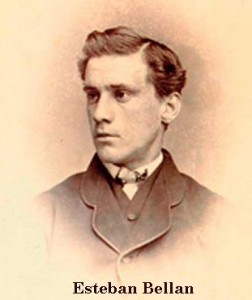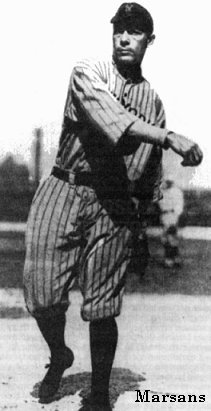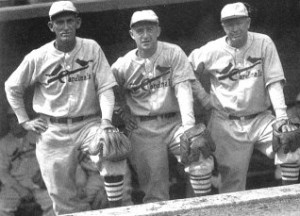CUBAN BASEBALL HISTORY
Although Cuban baseball legend has it that the native “Taino” Indians really invented the sport, baseball started to happen in Cuba around 1865. It was then that American students studying in the island taught fellow Cuban students how to play the sport. The game spread quickly, mostly due to the fact that the sons of wealthy Cuban families usually studied in American universities, where baseball was also spreading quite rapidly. Apparently the first organized baseball game in Cuba took place on December 27, 1874, when the Havana team beat the Matanzas team 51-9 at “El Palmar del Junco” baseball field. One of the Havana players was named Esteban Bellan, a catcher who was the first Cuban and the first Latin American to play major league baseball. Bellan learned how to play baseball while he was a student at Fordham University from 1863-1868.
During his time at Fordham, Bellan played for the newly created Fordham Rose Hill Baseball Club. This was the team that history tells us played the first ever nine-man team college baseball game in the United States against St. Francis Xavier College on November 3, 1859. In 1868 Bellan began to play for the Unions of Morrisania, an upstate New York team. A year later he joined the Troy Haymakers for whom he played third base until 1872. In 1871 the Haymakers had joined the National Association, which became the National League in 1876. The Haymakers later became the New York Giants, now the San Francisco Giants. Later on Bellan was instrumental, both as a player and manager, in establishing professional baseball in Cuba in 1878. He died in 1932.
As early as 1889, the US Major Leagues showed interest in Cuban players, when the legendary John McGraw, who visited Cuba regularly and eventually kept a permanent apartment in Havana, tried to sign a Cuban player named Antonio Maria Garcia (nicknamed “The Englishman” apparently because he was so fair of hair, eyes and skin). Garcia declined, since he was making a higher salary playing in Cuba.
In 1900, a Cuban player named Luis Padron (who as a pitcher had lead the Cuban league in wins and also in hits) was asked to try out with the Chicago White Sox. However, when doubts as to his racial purity were raised, the White Sox immediately released him and he never played. A couple of years later, John McGraw brought to the US a Cuban player named Luis “Anguilla” Bustamante, who he called “the perfect short stop.” Unfortunately for Bustamante, who was half black, his timing was off by half a century. Hearing of Bustamante’s prowess, around 1903-4, Clark Griffith, then with the New York Highlanders (later the Yankees), had Bustamante brought up for a try-out. As soon as Griffith saw Bustamante, according to Angel Torres, author of “The Baseball Bible,” Griffith ended the try-out and simply said: “Too chocolate.”
Let’s now move the clock forward to 1910, when four Cubans debut in the Minor Leagues: Armando Marsans, Rafael Almeida, Alfredo Cabrera and a second chance for Luis Padron. They play for the New Britain Class B team of the Connecticut League and a year later Marsans and Almeida begin to play for Cincinnati, and that’s truly when the issue of race becomes a question in the mind of ignorant racists.
As published in the Cincinnati Tribune on June 23, 1911: The Reds have signed two players from the Connecticut league who have Spanish blood in their veins and are very dark skinned. As soon as the news spread that the Reds were negotiating for the Cubans a protest went up from the fans against introducing Cuban talent into the ranks of the major leagues.
Cuban baseball legend has it that when August Herrmann, the president and owner of the Cincinnati Reds, went to the train station to meet them, he gasped when he saw two young black men come out of the train, and that he even approached them first. But they were not the Cubans. The two Cubans had an escort who had brought them to Cincinnati, and he in turn approached and spoke to a shaky Herrmann, who then met the Cubans for the first time. Herrmann was pleased and relieved about their appearance. They were not, as it was incorrectly reported in the next day’s paper, “small and swarthy in complexion,” [but showed] “practically no effects of the tropical heat and sun.” The Reds appeased the alarmed fans by assuring them that both of these players were of pure European blood. In fact, this was true, as according to Cuban sources and accounts of the times, Marsans was the son of Catalan immigrants to Cuba, and Almeida the son of Portuguese immigrants. This case of first generation Cubans was not that unusual in Cuba during the 1800s (both of them had been born in 1887) and even more after the Spanish-American War. The new nation had just achieved independence from Spain in 1898, and was in the midst of receiving large immigration waves from Europe. The large numbers of immigrants so alarmed native-born Cubans, that afraid that they would be outnumbered by European immigrants, Cuba severely curtailed immigration in the 1930s. In fact, according to Hugh Thomas, in the first decade of the 1900s alone, nearly 200,000 European immigrants arrived in Cuba. Considering that the 1899 census noted that there were around 1.5 million people in the island, this immigration wave, together with significant immigration by Chinese and Eastern European Jews in the 1920s, had a significant impact on Cuban society and ethnic diversity.
To make matters worse for Marsans and Almeida, it was customary with Cuban and other Latin American players, regardless of race, to play in the US Negro Leagues. In doing so, players could play year round: summer in the US and winter in Cuba. Both Marsans and Almeida had earlier played in the Negro Leagues.
This probably complicated things for Herrmann, and to further appease the fans, the Reds required that both Cubans bring notarized paperwork from the Cuban authorities, certifying that Marsans and Almeida were indeed white of unmixed blood. Eventually the Cincinnati press must have been convinced of the racial purity of the Cubans, as a story appeared indicating that the Cubans were “two of the purest bars of Castille soap that ever floated to these shores.” It is ironic that neither of the two Cubans was actually of any Castillian ancestry, but Catalan and Portuguese. It is also ironic, and erroneous, that several instances in recent books about Cuban baseball, by American authors, claim that either Marsans or Almeida was half black (and thus the first black person to play in the MLB). However, Cuban sources, such as Gonzalez Echavarria and Angel Torres, as well as the Cuban press of the time, clearly agree that both Marsans and Almeida were “blancos.” The unofficial honor of being the first player of evident African ancestry would fall on the broad shoulders of another Cuban a couple of decades later.
Cubans will also tell you that Marsans had accompanied Almeida as an interpreter, but when the Reds also tested him out, he ended up being the better player of the two and was also signed. Almeida played for the Reds for three years and Marsans ended up playing for many years for Cincinnati, St. Louis and the New York Yankees. In 1924 he also became the first Latin American to manage a professional US team, when he became the manager of the Elmira team.
The uniquely American cultural ignorance about the difference between ethnicity and race continues to this day (especially when dealing with whom we now refer to as “Latinos” or “Hispanics”), as Marsans and Almeida are still often referred to in articles and magazines as “light-skinned Cubans.” It is as if the fact that they were born in a Caribbean island had somehow mutated their racial ancestry. Although the abuse heaped upon them by newspapers, fans and other players eventually diminished, these two Cuban men played a key role in cracking open the race door, which would not open fully for many years later.
In 1912, Miguel Angel Gonzalez made his debut with the Boston Braves, and had a batting average above 300 for the four years that he played (1915-18) for the St. Louis Cardinals. Gonzalez spent 17 years in the majors, and also played for the Reds and Chicago Cubs.
But Gonzalez’s true contribution to the story is more profound than his modest .253 career batting average. In 1934, with his playing days over, he was hired as a coach for the St. Louis Cardinals, and in 1938 he was the interim manager for the Cardinals, becoming the first Latin American manager ever in the Major Leagues. He was fired in 1946 as a result of the famous controversy between MLB and Mexican baseball. Gonzalez is also one of the patriarchs of Cuban baseball, as he managed or controlled the legendary Cuban baseball team Havana Reds from 1914 until the end of professional baseball in Cuba in 1960.
Sources: Campello/InternetPhotos/TheCubanHistory.com







